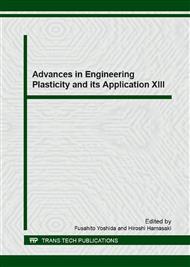p.149
p.156
p.162
p.168
p.177
p.183
p.189
p.195
p.202
The Evolution of the {110}<001> and {236}<385> Recrystallization Textures in Cu Alloys and High Mn Austenitic Steels with the Brass Rolling Texture
Abstract:
The {110}<112> rolling texture of Cu-22%Zn and Cu-30%Zn sheets having relatively low stacking fault energy transforms into the {236}<385> texture after recrystallization. The 40°<111> relation is approximately satisfied between the {110}<112> and {236}<385> textures. The 40°<111> relation is often addressed as a token of the oriented growth theory for the recrystallization texture evolution. On the other hand, Cu-16%Mn and Cu-1%P alloys and high Mn austenitic steels such as Fe-18%Mn-0.6%C, Fe-18%Mn-1.5%Al-0.6%C, and Fe-18%Mn-3%Al-0.6%C sheets having relatively high stacking fault energy also have the {110}<112> rolling texture, which transforms into the {110}<001> texture after recrystallization. The 40°<111> relation is not established between the {110}<112> rolling texture and the {110}<001> recrystallization texture. The differences are attributed to differences in the stacking fault energies of the materials. The phenomena can be explained by defects that dominates the stored energy of the rolled materials. When the grain boundary energy dominates the stored energy, the {236}<385> texture evolves after recrystallization. On the other hand, when dislocation energy dominates the stored energy, the {110}<001> texture evolves after recrystallization. The {110}<001> recrystallization texture evolution is well explained by the strain-energy-release-maximization theory. The 40°<111> relation is believed to originate in the maximum mobility of <111> tilt boundaries at a rotation angle of 40°.
Info:
Periodical:
Pages:
177-182
Citation:
Online since:
December 2016
Authors:
Price:
Сopyright:
© 2017 Trans Tech Publications Ltd. All Rights Reserved
Share:
Citation:


